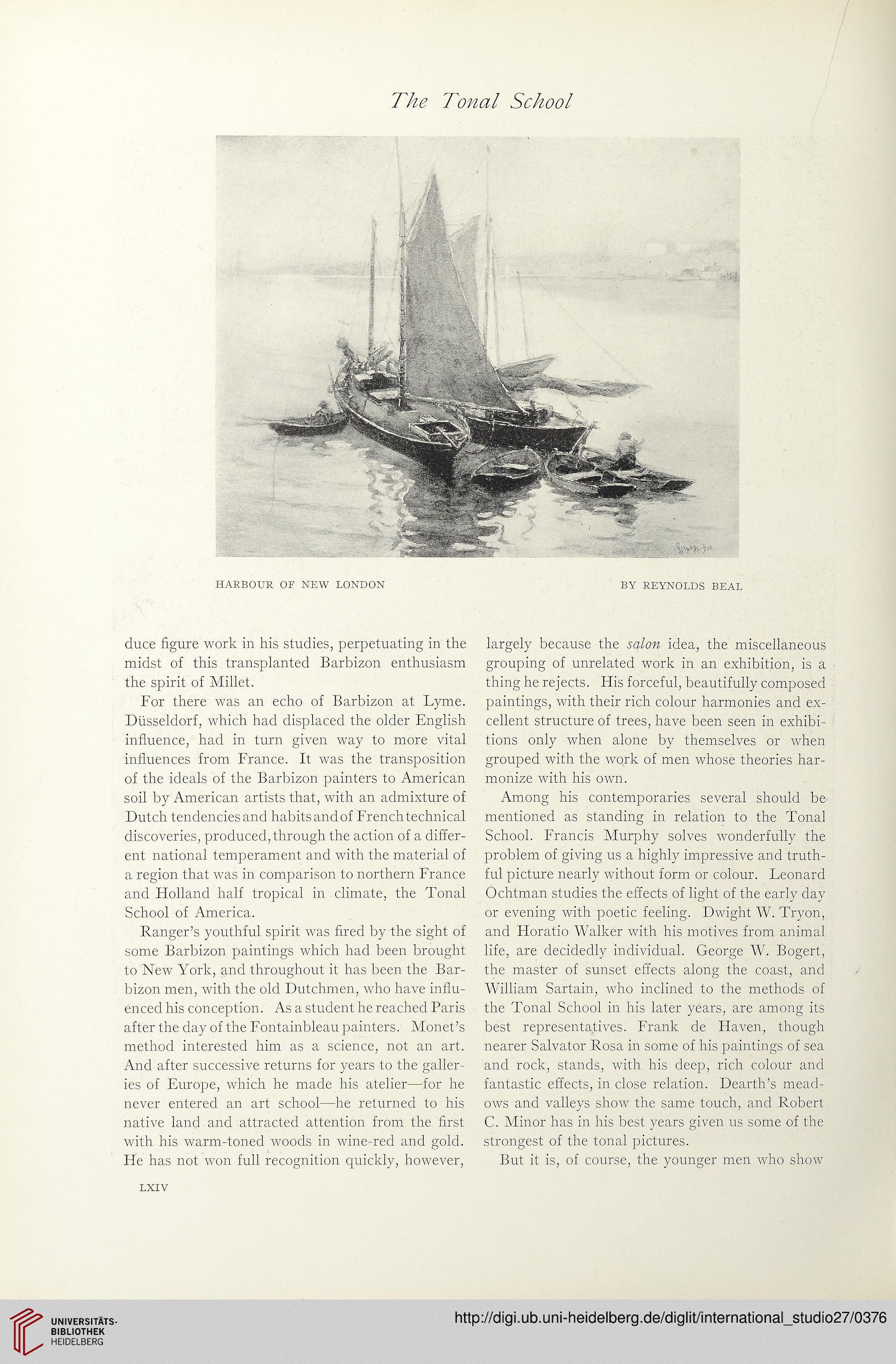The Tonal School
HARBOUR OE NEW LONDON
BY REYNOLDS BEAL
duce figure work in his studies, perpetuating in the
midst of this transplanted Barbizon enthusiasm
the spirit of Millet.
For there was an echo of Barbizon at Lyme.
Düsseldorf, which had displaced the older English
influence, had in turn given way to more vital
influences from France. It was the transposition
of the ideals of the Barbizon painters to American
soil by American artists that, with an admixture of
Dutch tendenciesand habitsandof Frenchtechnical
discoveries, produced, through the action of a differ-
ent national temperament and with the material of
a region that was in comparison to northern France
and Holland half tropical in climate, the Tonal
School of America.
Ranger’s youthful spirit was fired by the sight of
some Barbizon paintings which had been brought
to New York, and throughout it has been the Bar-
bizon men, with the old Dutchmen, who have influ-
eiiced his conception. As a Student he reached Paris
after the day of the Fontainbleau painters. Monet’s
method interested him as a Science, not an art.
And after successive returns for years to the galler-
ies of Europe, which he made his atelier—for he
never enterecl an art school—he returned to his
native land and attracted attention from the first
with his warm-toned woods in wine-red and gold.
He has not won full recognition quickly, however,
largely because the salon idea, the miscellaneous
grouping of unrelated work in an exhibition, is a
thing he rejects. His forceful, beautifully composed
paintings, with their rieh colour harmonies and ex-
cellent structure of trees, have been seen in exhibi-
tions only when alone by themselves or when
grouped with the work of men whose theories har-
monize with his own.
Among his contemporaries several should be
mentioned as standing in relation to the Tonal
School. Francis Murphy solves wonderfully the
problem of giving us a highly impressive and truth-
ful picture nearly without form or colour. Leonard
Ochtman studies the effects of light of the early day
or evening with poetic feeling. Dwight W. Tryon,
and Horatio Walker with his motives from animal
life, are decidedly individual. George W. Bogert,
the master of sunset effects along the coast, and
William Sartain, who inclined to the methods of
the Tonal School in his later years, are among its
best representatives. Frank de Häven, though
nearer Salvator Rosa in some of his paintings of sea
and rock, Stands, with his deep, rieh colour and
fantastic effects, in close relation. Dearth’s mead-
ows and valleys show the same touch, and Robert
C. Minor has in his best years given us some of the
strongest of the tonal pictures.
But it is, of course, the younger men who show
LXIV
HARBOUR OE NEW LONDON
BY REYNOLDS BEAL
duce figure work in his studies, perpetuating in the
midst of this transplanted Barbizon enthusiasm
the spirit of Millet.
For there was an echo of Barbizon at Lyme.
Düsseldorf, which had displaced the older English
influence, had in turn given way to more vital
influences from France. It was the transposition
of the ideals of the Barbizon painters to American
soil by American artists that, with an admixture of
Dutch tendenciesand habitsandof Frenchtechnical
discoveries, produced, through the action of a differ-
ent national temperament and with the material of
a region that was in comparison to northern France
and Holland half tropical in climate, the Tonal
School of America.
Ranger’s youthful spirit was fired by the sight of
some Barbizon paintings which had been brought
to New York, and throughout it has been the Bar-
bizon men, with the old Dutchmen, who have influ-
eiiced his conception. As a Student he reached Paris
after the day of the Fontainbleau painters. Monet’s
method interested him as a Science, not an art.
And after successive returns for years to the galler-
ies of Europe, which he made his atelier—for he
never enterecl an art school—he returned to his
native land and attracted attention from the first
with his warm-toned woods in wine-red and gold.
He has not won full recognition quickly, however,
largely because the salon idea, the miscellaneous
grouping of unrelated work in an exhibition, is a
thing he rejects. His forceful, beautifully composed
paintings, with their rieh colour harmonies and ex-
cellent structure of trees, have been seen in exhibi-
tions only when alone by themselves or when
grouped with the work of men whose theories har-
monize with his own.
Among his contemporaries several should be
mentioned as standing in relation to the Tonal
School. Francis Murphy solves wonderfully the
problem of giving us a highly impressive and truth-
ful picture nearly without form or colour. Leonard
Ochtman studies the effects of light of the early day
or evening with poetic feeling. Dwight W. Tryon,
and Horatio Walker with his motives from animal
life, are decidedly individual. George W. Bogert,
the master of sunset effects along the coast, and
William Sartain, who inclined to the methods of
the Tonal School in his later years, are among its
best representatives. Frank de Häven, though
nearer Salvator Rosa in some of his paintings of sea
and rock, Stands, with his deep, rieh colour and
fantastic effects, in close relation. Dearth’s mead-
ows and valleys show the same touch, and Robert
C. Minor has in his best years given us some of the
strongest of the tonal pictures.
But it is, of course, the younger men who show
LXIV




